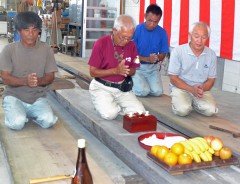Traditional sabani manufacturing process replicated for future generations

Photograph: On October 4 at the Itoman Uminchu Koubou Museum in Nishizaki, Itoman, people prayed for safety before starting to make sabani canoes.
October 10, 2012 Ryukyu Shimpo
The non-profit organization called Hamasuuki, which is based in Nishizaki, Itoman, and runs the Itoman Uminchu Koubou Museum and Arts and Craft Center, was commissioned by the Ocean Expo Park to manufacture two traditional Okinawan sabani canoes. On October 4, at the Arts and Craft Center, Hamasuuki held a ceremony to pray for safety before they begin manufacturing these canoes. It has been three years since the last sabani was manufactured in Itoman. The ceremony was held around high tide. Executive Director Uehara sat on the piece of timber seven meters long and one meter wide that had been prepared for the sabani and said, “We’ll start working on it from now.” Then he and two carpenters put some sacred sake on the timber, hit it three times with a hammer and prayed for the safety of the canoes.
There are two types of sabani. One is marukinni, which is made by hollowing out a piece of timber and the other is haginni, which has two boards joined together. On this occasion, they will make the standard style honhagi and nanyohagi.
There are only two people in Okinawa who can manufacture nanyohagi. One of these carpenters, Noboru Oshiro, said, “It has been almost 20 years since last time I made a nanyohagi. Although people are interested in sabani, most people know only honhagi. I want to pass down how to make it to future generations. Kiyoshi Oshiro and his student will be in charge of making the honhagi. Oshiro said, “A sabani is a work of art, and an example of our ancestors’ wisdom. We have to really treasure this opportunity.” The two sabani will be completed by the end of this year and will be exhibited in the Ocean Expo Park’s cultural museum.
(English translation by T&CT, Megumi Chibana and Mark Ealey)
Previous Article:OPG to ask Ministry of Defense for a reassessment of the environmental impact of Osprey
Next Article:Osprey aircraft flight paths continue to violate safety agreement
[Similar Articles]
- Repaired sabani sails again – Itoman Uminchu workshop
- Itoman Sabani boat builder wins MJC award
- Sailing Sabani Race held off Yambaru
- A dog recovers from paraplegia one year after a hit and run accident
- Exposition highlighting southern Okinawa will be held in October
 Webcam(Kokusai Street)
Webcam(Kokusai Street)


